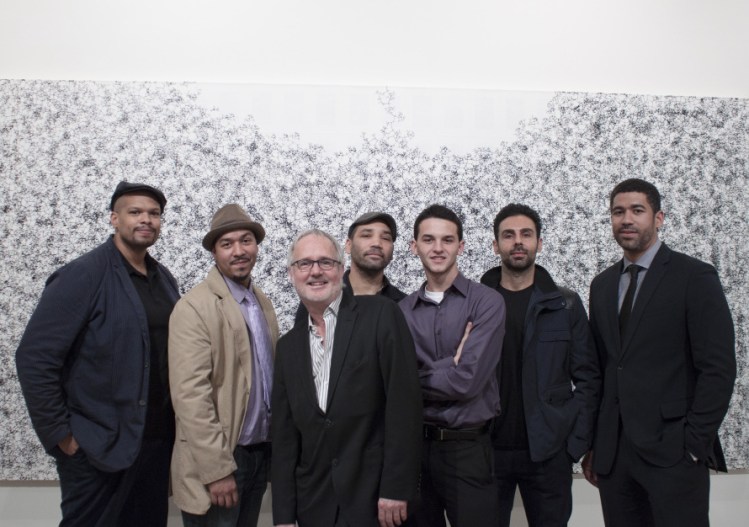Tim Rollins, an internationally recognized artist who grew up in Maine and whose work was featured last year by the Portland Museum of Art, died this week of natural causes.
Rollins, 62, lived and taught in New York City, but was born and raised in the central Maine town of Pittsfield.
“Everyone at the PMA was incredibly fond of Tim and deeply saddened by this loss,” the Portland Museum of Art said in a blog posted Thursday.
News of his passing came from the Maureen Paley gallery in London and Lehmann Maupin, a New York art gallery, which represented Rollins. The galleries said a public memorial to celebrate his life, which has not been arranged yet, will be announced at a later date.
Rollins studied fine art at the University of Maine in Augusta before earning his bachelor’s degree in fine arts from the School of Visual Arts in New York City. In 1981, at the age of 26, he began teaching special education in the South Bronx. His students were classified as being academically or emotionally at risk.
“Today we are going to make art, but we are also going to make history,” Rollins reportedly told his middle school students on their first day of class, Art News reported.
In 1984, he established an after-school program that became known as the Art and Knowledge Workshop, which led to the formation of K.O.S., or Kids of Survival, an artist collective that runs workshops for children.
Visitors to the Portland Museum of Art in the past year probably would have seen an oversized, colorful installation titled “A Midsummer Night’s Dream” that was created by Rollins and K.O.S.
Rollins and his artists’ collective began to earn worldwide recognition in 1985 when they were invited to appear at the Whitney Biennial, an exhibition of contemporary American art in New York City. That was followed in 1986 by solo exhibitions in the East Village and the Bronx.
Jessica May, arts deputy director and chief curator at the Portland museum, was instrumental in getting Rollins and K.O.S. to come to Maine in September 2016 with their art exhibition “Unbound,” which drew thousands of visitors. The exhibit ended last Dec. 31.
Rollins embraced the concept of working collaboratively to create art. In 2016, he was quoted by the Portland museum as saying that he learned a lot from watching women patch quilt panels together in his hometown of Pittsfield.
“We do everything through the power of ‘our,’ ” Rollins told the PMA. “That was the incubus for K.O.S. I said, ‘You know what? If you want to build a barn, you don’t study the theory and practice of barn building. You build a damn barn, and if the barn’s broken, what do you do? You fix it.’ I just took that homespun philosophy, and we created our own situation. Independent, libertarian. I got that from home.”
During his visits to Portland, May got to know the artist she describes as “one of the most profoundly gifted artists that I have ever worked with.”
“I valued him as a friend, and I think there was such deep inspiration in the way that he embedded his teaching and his art practice together,” May said.
Rollins was also a skilled instructor, she said. He and his K.O.S. students combined lessons in reading and writing with production of works of art. In a creative process that Rollins called “jammin,” he or one of his students would read aloud from assigned texts while everyone else drew or painted, relating the stories being read to their own life experiences.
“Tim was a real educator. He really believed in the future,” May said. “I think what made him an amazing human being is he wasn’t just in it for himself. He believed in helping others and paying it forward.”
Several of his K.O.S. students established careers as artists, May noted.
“Tim really transformed their horizon of possibility, and he loved them,” she said.
In Thursday’s remembrance blog, May spoke fondly of her friend.
“He often told the story of the first work of art he’d ever seen, a high-in-the-air, rotating, electric Sunoco sign in central Maine that never failed to regain its wondrous glory in his repeated descriptions,” May wrote. “I loved that story because it reinforced for me a powerful idea that art is not about propriety and boundaries, it’s not about the taste of the wealthy, and it’s not even really about museums and art history classes.
“Tim made it clear that art was about something wilder and more closely connected to us humans in our deepest recesses and most childlike delights. Tim also made it clear that the bright, obscure majic of art, the alchemy, was located not in it its remoteness and distance, but in its immediate accessibility, its power to transform every life.”
Dennis Hoey can be contacted at 791-6365 or at:
dhoey@pressherald.com
Send questions/comments to the editors.




Success. Please wait for the page to reload. If the page does not reload within 5 seconds, please refresh the page.
Enter your email and password to access comments.
Hi, to comment on stories you must . This profile is in addition to your subscription and website login.
Already have a commenting profile? .
Invalid username/password.
Please check your email to confirm and complete your registration.
Only subscribers are eligible to post comments. Please subscribe or login first for digital access. Here’s why.
Use the form below to reset your password. When you've submitted your account email, we will send an email with a reset code.